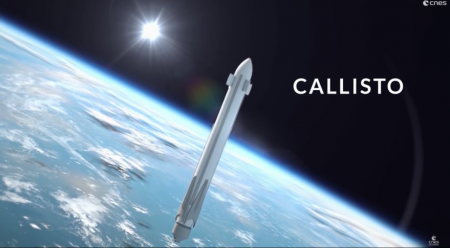January 9, 2018 – SpaceX and Blue Origin are establishing re-usability as a standard for satellite and human-crewed launch systems. SpaceX has successfully recovered 20 of its Falcon 9 first stage boosters since it demonstrated this capability back in 2015. It has also reused 5 of these first-stage boosters in subsequent missions.
Blue Origin’s efforts to date or more modest. The company has demonstrated with its New Shepard single-stage rocket, controlled launch, descent, and reuse. It intends to further develop this technology for its next-generation launch vehicle, New Glenn, designed to put payloads into orbit.
Joining the two now are two member nations within Europe’s space program: Germany and France. Their goal is to advance the Ariane program by developing a first stage rocket prototype dubbed Callisto. The timetable for Callisto’s first flight is 2020.
Callisto is being developed in parallel with a new engine designed for multiple firings and reuse. Called Prometheus, the engine is a joint venture by the French agency, CNES, and the German DLR. Initial funding is coming from the European Space Agency’s Ariane 6 budget. Each agency has its own expertise. The French are focused on the guidance system and flight software. The Germans are developing trajectory, aerodynamics, and aerothermodynamics systems. The engine will run on liquid hydrogen.
States Hansjörg Dittus, of DLR, “It’s not a copy of what SpaceX is doing. In some aspects we are also skeptical [about reusability as] the right path, but we will see what is best and then we can come up with ideas of how we proceed.” The two agencies are still working out whether the first stage rocket needs wings, the engine throttling functionality, and the final engine materials and design to ensure multiple reuse.
Marc Astorg, the head of CNES’s Launch Vehicles Directorate, is not concerned that SpaceX currently has a substantial lead. He believes it’s not always good to be first when creating a new paradigm. For example, he thinks that the use of kerosene as the fuel for SpaceX’s Merlin engines in their Falcon 9 program, is a dead end, whereas hydrogen or methane would be easier fuels to handle. SpaceX in its next generation of rockets is switching from kerosene to hydrogen.
When Callisto is ready to fly in 2020 it will not use Prometheus because the prototype will be too small for that engine. The test rocket will measure 13.5 meters (44 feet) in height and 1 meter (3 feet, 3 inches) in diameter. But first flight will be useful in proving that the design works and is flight stable. For Prometheus, a larger version of the rocket will need to be designed. That may end up being the Ariane 6 which is expected to see its first flight in 2020 and may incorporate the Prometheus engine. But for now, Ariane 6 is not being designed with re-usability in mind.









